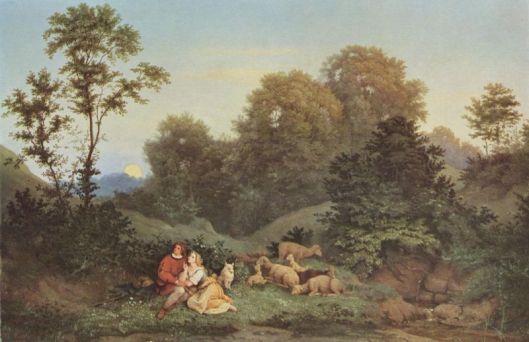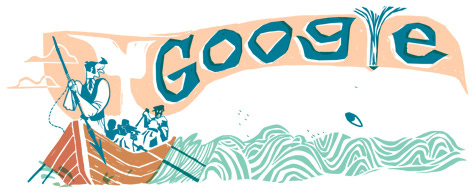The following review of Sammy Harkham’s comic Poor Sailor originally appeared on Icon Sequential, another WordPress blog project I undertook with a very talented colleague a few years ago. I’m reissuing the essay on Verba Americana because Harkham is an imposing American talent.
The Deckhand Tragedy: Sammy Harkham’s Poor Sailor
Review by Joseph Frank (originally published on 2 December 2011)
The ocean has been on my mind. Melville’s Moby-Dick, of course; also Billy Budd. But I’ve been reading short fiction by Guy De Maupassant, as well. So it was a pleasure to discover his story, “At Sea,” which shares moral and thematic elements with Melville: an intense interest in the ill-fated curiosity of humans to find profit in the ocean; the ocean’s intolerance of humankind’s lice-like presence; among humans, a compassionless leader more concerned with his mission than his crew; a lonely conclusion, emphatically silent, focused on the protagonist’s orphanlike existence, which, upon reflection, is logical, unavoidable, but no less tragic.
Maupassant’s “At Sea” is about a young man called Javel Jr. on board a trawling smack captained by his older brother, Javel Sr.. When Javel Jr.’s arm becomes tangled in the rope pulling a net filled with fish, Javel Sr. refuses to cut the rope, which would cost him the net and catch. When they finally drop anchor and slacken the net, Javel Jr.’s arm is gristle. For days he ladles sea water over the wound, but gangrene sets in and he finally amputates his own arm. The fishermen examine it. They preserve it in salt. Once home, Javel Jr.’s family examine it. The carpenter builds a small coffin and a funeral is held. Javel Jr. gives up the sea and recalls the incident as the day his brother chose profit over blood.
Of the many stories Maupassant penned, “At Sea” is, perhaps, not counted among his most well-known.

Along comes American comic creator Sammy Harkham, maker of the esteemed avant-garde comics anthology Kramer’s Ergot, who adapts “At Sea” to comic form. That Harkham’s Poor Sailor (the title of his adaptation) can be read in less than fifteen minutes speaks nothing to the time it requires. It is a taciturn but deeply multilayered story. It maintains the concision of Maupassant’s original, in its parts and as a whole. The motivating hopes of the characters leads to brutalities that recall Melville. And something of Harkham’s decision to expose the story in reticent and ostensibly uncomplicated illustrations summons the sentences of Chekhov and Hemingway. It would be apt to use Poor Sailor to coin the term “graphic short story,” as opposed to the ever popular “graphic novel,” but that’s not my concern. What strikes me is how Harkham’s visual style and panel pacing unite traditional slapstick cartoon aesthetics with a deeply realist moral universe laden with ambivalence and tragedy.

Poor Sailor opens on pastoral domesticity. The main character, Thomas, lives in Edenic seclusion with his wife, Rachel. They are completing or repairing the thatch roof of their small house. They work, flirt, stroll, and skinny-dip. One day, Thomas’s older brother, Jacob, arrives. He encourages Thomas to join the crew of his trawling smack. Rachel refuses: Thomas has domestic responsibilities and her wellbeing to care for. As days pass, Thomas and Rachel grow distant, preoccupied by differing opinions of Jacob’s offer. One night, Thomas rises and says Rachel’s name – to wake her or to make sure she’s asleep, it’s unclear – but she sleeps and he leaves. Work aboard the smack is brutal. In foreign ports, Thomas is tempted by prostitutes, tattooed, and fed horrible food. He witnesses human cruelty far darker than anything in his life with Rachel. And the ocean is no kinder. One day, in particularly rough water, Jacob insists they drop the nets. Here, Harkham remains close to Maupassant: Thomas’s arm is caught and then crushed when Jacob refuses to cut the nets. Where Maupassant details the process of pouring salt water on the wounds, Harkham skips to the moment when they decide the arm must go. Jacob advises the amputation. It is unclear who performs the deed. Less an arm, Thomas remains with the ship, unable to work, dreaming of Rachel. One night, somewhere between the Indian Ocean and the Philippine Sea, they are ambushed by masked pirates who slaughter everyone. The ship burns and then sinks. Thomas clinging to debris. A rowboat filled with missionaries saves him. By foot and train, through valleys and forests, as snow begins to fall, Thomas returns home. When he arrives, he discovers a burial mound marked with a cross. He falls on his face. Five empty panels progress like weeks of silence. Finally, one-armed Thomas continues repairing the roof alone.

Harkham’s illustrations are darkly juvenile, and yet they recall well-established, indeed even watershed events in comic history. The aesthetics of his characters and scenes recall the stark monochromatic worlds of early Walt Disney and Ub Iwerks cartoons like Oswald the rabbit (Trolley Troubles 1927) and Mickey Mouse in Steamboat Willie (1928), as well as the Little Orphan Annie comics of Harold Gray (including unnervingly empty circles for eyes), and, more recently, Harkham’s Drawn & Quarterly colleague, Chester Brown, who cites Gray as an influence (Louis Riel: A Comic Strip Biography, “Forward”). Brown also cites Hergé, creator of Tintin; Harkham’s style equally references the French method ligne claire: clear line. But Harkham’s illustrations succinctly elaborate the oddly grotesque morphology of styles like those listed. Such characters usually exist according to the nonsensical, slapstick physics of hokey cartoon universes, but Harkham’s style asks what if the universe of such weird looking figures was ruled by moral ambiguities like our own? What if their strange bodies stood for something more than cutesiness? What if their look was the product of personifying how fucked up life is? With crisp precision, the weak shoulders, crudely large hands, dullard expressions, and hollow eyes of his characters transform the substances of their psychological lives and the unsympathetic fates into correspondingly ill-proportioned bodies.

Unlike the early Disney/Iwerks characters, who easily recover from myriad physical brutalities, Harkham’s characters are not so invulnerable. The story hinges on the event of mutilation and amputation. When Thomas loses his arm, our presuppositions of the traditional conventions of this illustration style are attacked. As Leonard Michaels argues about the goring of Hernandorena in Hemingway’s Death in the Afternoon (1932), Thomas – and, by extension, the graphic narrative tradition after which his aesthetic follows – is more essentially himself with a stump where his arm once was (“What’s a Story”): no character who is worth caring for, worth investing in, worth feeling pathos toward, is invincible. Pathos requires ambivalence, inarticulateness (depicted both literally and illustratively in Poor Sailor), and a sense that good intentions of best laid plans are in direct conflict with cruel fates against which we are helpless. The loss of Thomas’ arm represents the magnitude of what’s at stake. The stoicism of the characters and the narrative, especially when it is decided that Thomas’ arm must be severed, represents the only logical response to such an existence: ambivalence, bewilderment. And they foreshadow an even greater loss awaiting Thomas, one which serves to further expand the tragedy of his choice to leave Rachel: her death.
Another feature of Harkham’s style that brings the cartoonish aesthetic into our moral universe is his penchant for eliding decisive scenes, for letting them occur between panels; the audience gets a picture of the instant before a major event and the fallout thereafter. The event itself – Thomas’s departure, the moment of his injury, the amputation, his escape from the pirates, Rachel’s death – are suggested as though glimpsed by way of events signal them, rather than illuminating them in full. Lacunae like this bear the mark of Old Testament realism and, on Harkham’s behalf, are an ingenious exploitation of the ‘gutters’ between panels, or perhaps an ingenious investment into the gutter’s potential to host moments of unsayable and unseeable importance. Events so important they oppose articulation.
Early in the book, we glimpse one such event, after which all comparable events are omitted. Concluding the pastoral introduction, Hakham illustrates Thomas and Rachel standing naked in water, holding hands in silence, looking at one another with uncertain expressions. It is a definitive moment in the text – the height of what six panels preceding it worked toward: laying bare the couple’s love, simple though it may seem. It haunts the remainder of the story. It infuses the maiming of Thomas with the sense that he is not the only one injured – to return home with only one arm means he must forever bear the wound of betraying Rachel as well as the myriad ways it would impose upon Rachel. But that scenario, no matter how humbling and inconvenient, is no match for how the story actually ends, with Thomas returning to find that Rachel has died in his absence.

As I try to conclude this less-than-half-adequate review of Poor Sailor, I’m burdened by the feeling that I’ve done it a major injustice. I’ve barely articulated the story’s power to evoke unplumbed and unplumbable depths, which is achieved, in large part, by Harkham’s mastery of storytelling and illustration. Indeed, his revision of classically cartoonish iconography and his brilliant exploitation of gutter silences make for a taciturn tragedy that increases the scope of his imaginary, expanding it through the abovementioned cartoon traditions, while also gesturing Melville, Chekhov, Hemingway, and the Old Testament. (Thomas’s lone survival following the massacre by pirates echoes Ishmael floating on Queequeg’s coffin after Moby-Dick sinks the Pequod; his single-panel train journey home recalls Hemingway.)
“Poor Sailor” is a beautiful book. A heartbreaking story. An expert instance of narration by sequential pictures. An impressive example of the potential of the comic form for artful adaptation and, in this case, improvement of already impressive source material – though this last point has much to do with Harkham’s genius. It exhibits the power of pictures to tell a story with heavy emotional impact, without resorting to graphic gratuitousness or melodrama. Harkham disarms us with cartoonishness, draws us in with darkness, involves us by requiring interpretation between panels, and creates characters whose outer appearances reflect how feeble humans are, how grotesque our betrayals, failures, and fates.
– Joe
































